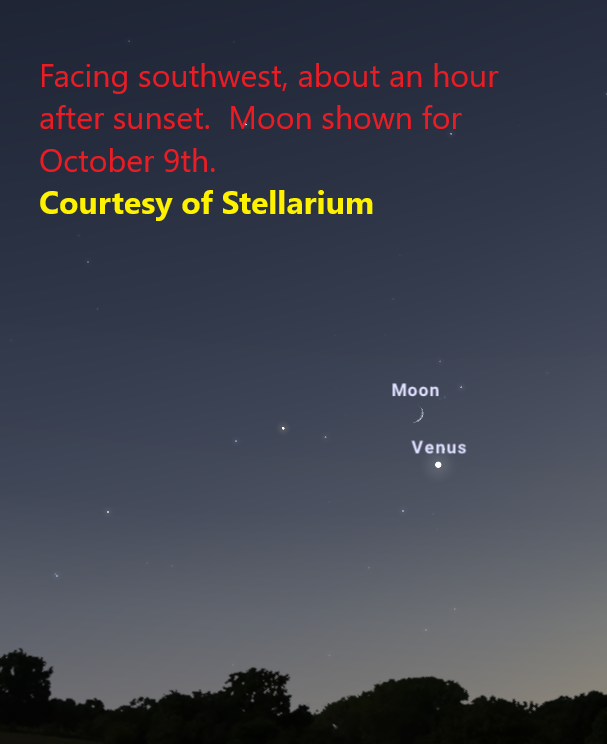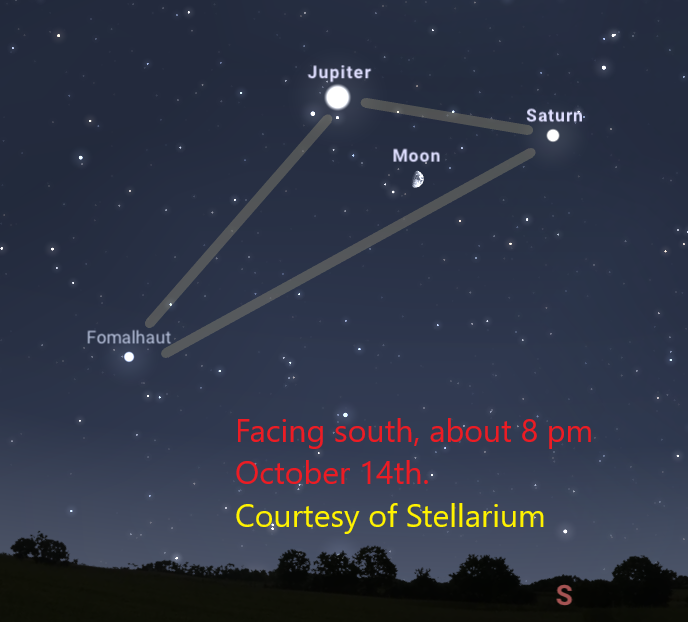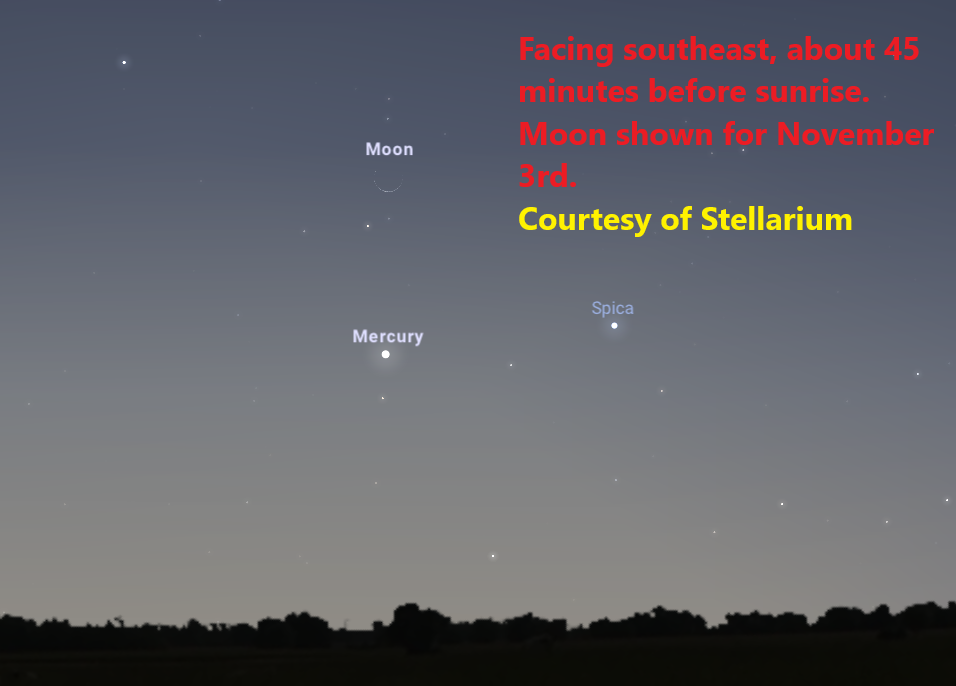FALL PLANET FEST
This fall presents a fine chance to view four planets easily with your unaided eyes. Only Mars, which appears on the far side of the Sun as seen from Earth, will not be in view. It will begin to emerge into the morning sky next month. Planets shine by reflected light from the Sun, and how bright they appear to us is dependent upon how well they reflect this light, how close they are to the Earth, how much light they receive from the Sun, and how they large a planet they are. Venus excels at all of these factors except the last one, and always appears as the brightest starlike object in the sky, unless perhaps it is dimmed by bright twilight close to the horizon.
This fall, Venus will shine brilliantly in the southwestern sky for about two hours after sunset. The image below shows the thin Moon’s close approach to Venus on the night of October 9th. This is always a pretty event, since you can often see earthshine- the outline of the unlit part of the Moon, faintly lit by sunlight reflecting off the Earth on to the Moon, and then back again. Bring out a pair of binoculars to see the earthshine better. If you have a camera that you can place on a tripod, try to take a time exposure of a second or so to show Venus and the Moon together with some feature of the landscape- it can be a pretty composition! If you don’t have clear skies on October 9, there will be two more good chances during the current evening apparition of Venus- on November 7 and December 6. If you have a telescope, you can watch Venus’ phase change from gibbous (more than half full) during the course of this fall.

Not quite as brilliant as Venus, Jupiter still manages to dominate its portion of the sky- the southeast to south during the early evening. Good quality, steadily held binoculars can show some of Jupiter’s four largest moons, popularized by Galileo in the early 17th century. Saturn’s magnificent ring system can be seen in a small telescope, with the planet appearing this fall as the next bright “star” to Jupiter’s right. Some of you may remember the Great Conjunction of these two outer planets last December- they are still relatively close together this year. Although it appears much dimmer than Jupiter, Saturn still appears as a match for the brighter stars in the sky, despite being twice as far away as Jupiter and receiving much less light from the Sun. The moon will form a triangle with Jupiter and Saturn on the night of October 14 (shown below), and will be similarly situated on November 10 and December 8. Due to its rotation around the Earth, the Moon will appear closer to Saturn a night before these dates, and to Jupiter the night after the dates listed here. At this point in their 12 year and 29.5 year orbits around the Sun, Jupiter and Saturn form a long triangle with the star Fomalhaut, often termed “the lonely star” because there usually are no other bright objects near it- but not so this year!

With fall now underway, the sun is rising ever later in the morning and setting earlier in the evening. Take advantage of this to get a good view of Mercury, the innermost planet, during the second half of October and the first week of November. Mercury will appear as the only fairly bright “star” low in the east southeastern sky in the dawn, about 45 minutes before sunrise. Since it is seen against the twilight background, Mercury does not shine as conspicuously as the other planets, unless the sky is very clear. The thin crescent moon can help cinch the identification on the morning of November 3- think photo opportunity!
Perhaps you can capture the waning crescent moon (along with earthshine), Mercury, and the star Spica- see the directions for Venus above! There is a persistent legend that the famed astronomer Copernicus never saw Mercury, although this is probably not the case. Certainly, most non-hobbyists have never seen Mercury, but it isn’t hard at all to find during a good appearance like this one. Since the innermost is always seen rather low on the horizon before sunrise or after sunset, it requires a spot with an open view to the eastern or western horizon. Bringing along binoculars can help, especially to spot Spica, since it will appear a lot dimmer than Mercury on November 3.

Join us for the last Gateway to the Stars program for 2021. This program will be all in person, held at the West Entrance Plaza beginning at 6:30 pm on October 16. A Park Ranger will present the traditional “Ghosts of the Arch Grounds” talk, focusing on how the area of the Arch Grounds has been central to the history of St. Louis, featuring the adventures and misadventures of some of the people involved. Weather permitting, free telescope viewing will follow. The moon, Jupiter, and Saturn will be shown off by volunteers from the St. Louis Astronomical Society. The “Ghosts” tour will take place unless there is rain, while heavy cloud cover would cancel the telescope viewing.
